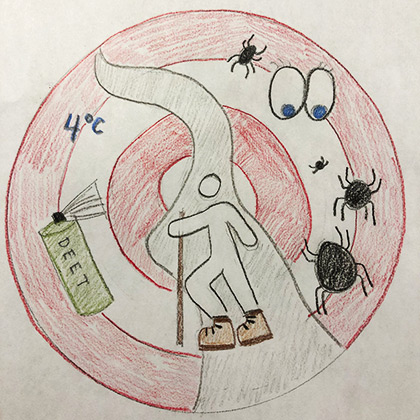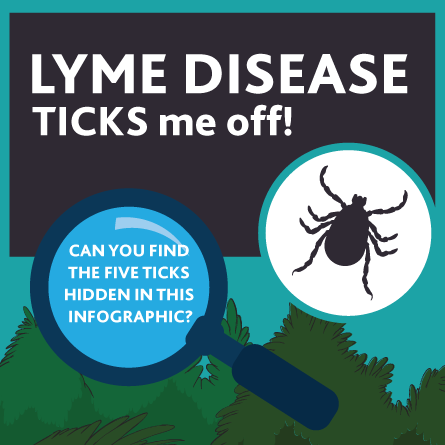Lyme disease, caused by the bacterium Borrelia burgdorferi, is spread through the bite of infected ticks. The best way to protect yourself from contracting Lyme disease? Preventing tick bites!
Scouts across the country put their creativity, knowledge, and talents into designing a crest that highlights the importance of preventing tick bites and highlighting Lyme disease awareness.
Congratulations to Calvin Bell from 1st Nottawa Group, in Shining Waters Council, for this inspiring design.

Learn how, what, and why these bacteria really ‘tick’ us off.
For even more information on the prevention of Lyme disease, visit the Public Health Agency of Canada’s website at www.canada.ca/Lymedisease.
Scouts Canada is proud to partner with the Public Health Agency of Canada (PHAC) to raise awareness of ticks and Lyme disease this spring. Let’s learn more about ticks, the Lyme disease they can spread, and what we can do to stay safe as we embark on our Scouting adventures this season
Did you know:
- Ticks can be the size of a poppy seed?
- Ticks can be found throughout Canada?
- Lyme disease is spread through infected blacklegged ticks? And
- Blacklegged ticks are active when temperatures are 4°C and above, which includes mild winter days?
It’s important to identify and understand the risk of tick bites, how to prevent them, and how to remove a tick if you are bit.
Signs and Symptoms
Early signs and symptoms of Lyme disease may include:
- Rash, sometimes shaped like a bull's eye
- Fever
- Chills
- Headache
- Fatigue
- Muscle and joint aches
- Swollen lymph nodes
Consult your health care provider right away if you develop symptoms of Lyme disease after being bitten by a tick or if you visited a known ‘at risk’ area for Lyme disease. The earlier a diagnosis is made, the greater the chance of a successful treatment.
Scouting Tip: if you find a tick attached to you, SAVE it in a sealed bag or container.
If you saved the tick that bit you, bring it to your medical appointment. Tell your doctor:
- How long you estimate that the tick was attached to you
- Where you were when you were bitten by the tick
Prevention
Here are just some ways to help prevent tick bites:
- Wear light-coloured, long-sleeved shirts and pants to spot ticks more easily.
- Tuck your shirt into your pants and pull your socks over your pant legs
- Use bug spray containing DEET or Icaridin on your skin and clothing (and always follow the directions on the label)
- Walk on cleared paths or walkways.
- Do a daily full-body check for ticks on yourself and your children, especially in the hair, under the arms, in and around the ears, inside the belly button, behind the knees, between the legs, and around the waist.
Scouter Support
Scouters can find a tick and Lyme disease module on the David Heustis Learning Center and can learn in-depth information on ticks, Lyme disease, and way to prevent tick bites.

RESOURCES
Learn more about tick and Lyme disease by checking out these great resources.
Deadline March 31st, 2023
Scouts Canada is proud to partner with the Public Health Agency of Canada (PHAC) to raise awareness of ticks and Lyme disease this spring. Let’s learn more about ticks, the Lyme disease they can spread, and what we can do to stay safe as we embark on our Scouting adventures this season.

